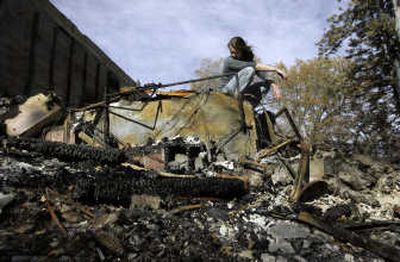Beauty has trade-offs in fire-prone areas

LAKE ARROWHEAD, Calif. – The hand-painted sign in front of the home, one of just a handful still standing amid mind-boggling destruction, credited a higher power for the house’s unlikely survival: “We believe in miracles.”
Yet Adrienne Freeman, a Yosemite National Park official who has been working the California fires for nearly a week, believes something very different can explain why some structures here survived the fires and others were reduced to rubble.
“Some people up here are extremely, extremely fire savvy,” Freeman said, speaking of the beautiful communities – many of them vacation destinations – around picturesque Lake Arrowhead. “Many of them have done everything possible to reduce the likelihood that their homes will be lost in the event of a fire. Others have not been as vigilant.”
The breathtaking views, the peace and the fresh mountain air around Lake Arrowhead help explain why so many people continue to build homes in such a fire-prone area.
But experts such as Freeman say the trade-off for such natural beauty must be a dramatic shift in construction techniques, in forest thinning, in landscaping patterns to decrease the chance that so much will be lost each year in blazes such as the Slide and Grass Valley fires that have consumed close to 300 homes around this lake recently.
People, for example, must stop building quaint vacation homes with highly combustible shaker siding and enormous wrap-around wooden porches. They must agree to clear some of the very trees they are leaving the city to appreciate. They must surround their homes with rock pathways that serve as fire breaks instead of extensive landscaping that will quickly go up in flames.
“A lot of residents are skeptics,” said Veronica Magnuson, a lands officer for the U.S. Forest Service in San Bernadino County, home to Lake Arrowhead’s communities. “A lot don’t want to cut down a single tree. It’s essentially a problem of loving our forests and this area to death.”
The points Freeman and others make are illustrated by one lonely structure standing at a point of lookout over Grass Valley, just west of Lake Arrowhead. The houses around it are gone, and combing through their rubble one can discover they had wooden shake roofs and wooden siding. In contrast, the surviving home is stucco with slate and stone detailing.
The heat the home endured was so intense that the exterior paint is cracked and peeling and most of the windows have broken out. The eaves have little overhang, a deliberate design that prevents blowing embers from becoming trapped under them and starting the roof on fire.
“It is not an accident this home is still here,” Freeman said.